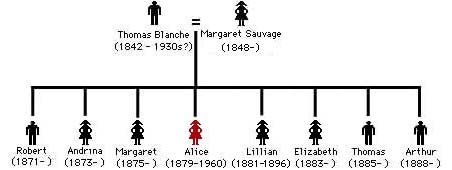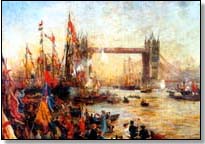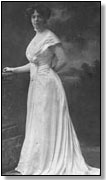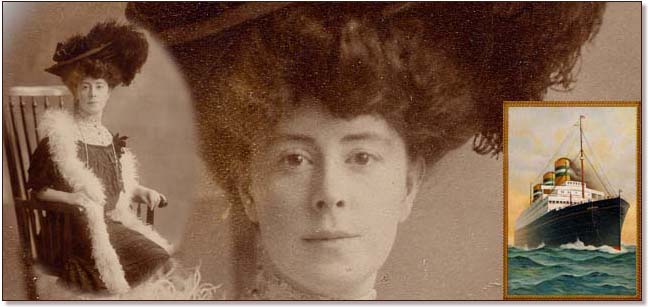|
1 A WORD OF EXPLANATION
REGARDING FACT VERSUS FANTASY
There is very little about Thomas Blanche and his family that we
know for fact. What I have written here will be an evolving story. It should not
be viewed so much as a history but as a developing historical fiction, a framework
for reconstructing the Blanche-Sauvage family
of late Victorian London, Poplar and what happened to the descendants. It is based upon a variety of family stories (mostly related by Norman
Miller, the son of Alice Blanche) combined with a developing body of documentary
facts (vital records, census records, etc.). Inevitably as more facts are discovered
the reconstruction will change, and as will be noted above, the story stops short
a full century ago.
2Birth dates came from a search of the
online International Genealogical Index (IGI), on the Family Search site, http://www.familysearch.org
3 Death dates came from correspondence
with Alan Beattie, a Blance 5th cousin in an England and a recently created Blance
web site, http://familytreemaker.genealogy.com/users/t/h/o/Karen-B-Thomas, created by Karen Blance Thomas, a Blance 5th cousin from new York.
Father = Robert Blance (1792-1851)
Mother = Ann Laurenson (1802-1879)
Sister = Ann (1830-1910)
Sister = Ursula (1833-1899)
Sister = Andrina (1835-1912)
Peter = (1839-1907)
4 http://familytreemaker.genealogy.com/users/t/h/o/Karen-B-Thomas
5 Alan Beattie, "Blance: The Origin of the Family,"
Coontin Kin (Shetland Family History Society, Lerwick, n.d.).
6 Liv Kjørsvik Schei, The Shetland Story
(Hippocrene Books, New York, 1988) p.157.
7 Calback no longer exists, having been
destroyed in 1975 after the discovery of North Sea oil to the northeast of Shetland
and the construction of the Sullom Voe Oil Facility which was created to accommodate
the tankers (Alan Beattie email, 7/99).
8 Alistair Goodlad, "Five Centuries
of Shetland Fisheries," Shetland and the Outside World 1469-1969, Donald
J. Withrington, ed. (Oxford University Press, Oxford, 1983) p.110.
9 Schie, p.126.
10 Quoted in Schie, p.127.
11 William P.L.Thomson, "Population
and Depopulation," Shetland and the Outside World 1469-1969, Donald J.
Withrington, ed. (Oxford University Press, Oxford, 1983) p.158.
12 A number of sources have been consulted
to provide some flavor of what life for a boy and teenager might have been like in
Shetland in the middle of the 19th century:
Callum G. Brown, Up-helly-aa: Custom, Culture and Community
in Shetalnd (Mandolin, Manchester University Press, Manchester, 1998).
Edge of the World
Mollie Hunter, A Stranger Came Ashore (Harper Trophy, New
York, 1975).
A children's novel about life in 19th century Shetland.
John J. Graham, Shadowed Valley (Shetland Publishing Co,
Manchester, 1994).
A novel based on the Weisdale Evictions of the mid-19th century.
W.P. Livingstone, Shetland and the Shetlanders (Thomas Nelson
& Sons Ltd., London,1947).
Liv Kjørsvik Schei, The Shetland Story (Hippocrene
Books, New York, 1988).
Stella Shepherd, Like a Mantel, the Sea (Ohio University
Press, Athens, Ohio, 1971).
An account of life on Papa Stour in the mid 20th century.
Jonathan Wills, The Land of Garth: A Short History of Calback
Ness (The Shetland Times, Ltd., Lerwick, 1978).
31 Norman Miller often repeated this
as a story that his mother Alice Blance Miller had told him. He remembered it well
because he was something of a swashbuckler himself. He also lamented that he used
to have a folding secretary (writing desk) that had been aboard with the ancestor
who sailed with Nelson but that in a fit of generosity he had given it to his attorney
sometime during the 1980s.
32 This photo is probably of a Sauvage ancestor since
the rear is imprinted with " W. Bartier - East India Road- Poplar - Portrait
Painter and Photographer." The hair style and dress of this woman appears to
be much earlier than the turn-of-the-century dress style in the rest of Alice's album
and perhaps earlier than that of Margaret Blanche above. Is it possible that the
baby is Margaret and her mother, Mary Ann, about 1850? The identification of Margaret's
mother as Mary Ann Sauvage is based on the evidence presented in the footnote below.
33 At this point (9/2001) I cannot prove that Margaret
Sauvage was the daughter of Mary Ann Sauvage and the sister of Richard and Henry.
I conclude that they are very likely candidates for the following reasons: 1) the
Mary Ann, Henry, Richard family, along with a lodger/butcher, William Sauvage, are
listed in the 1881 census from 31 Cawdor St, Bromley and are the only Sauvage family
from Bromley at that time; 2) Margaret is consistently listed on the birth certificates
of her children as coming from Bromley; 3) Richard Sauvage was exactly the same age
as Thomas Blanche; 4) Thomas, Richard and Henry all were seamen/shipwrights; 5) the
address given at the time of the birth of Thomas and Margaret second child appears
to be right around the corner from the 31 Cawdor St. address (I cannot check the
numbers at this time but the streets are short and cross each other).
On the other hand, I was not able to find the Mary Ann Sauvage
household in the 1871 census (when Margaret had married Tom), and I have not yet
been able to search for the 1861 census when Margaret would still have been at home
with her mother.
34 The exact
date of Thomas and Margaret's wedding is not known. I was unable to locate a marriage
record when I searched for the years 1865-1871 in the FRC (6/99).
35 125 Canton St., Poplar according
to the 1871 (April) census.
36 This reconstruction is based on the
following facts: 1) the 1871 census address is 125 Canton St., Poplar and the 1881
census address is 124 Canton St., Poplar; 2) the Blanche's first two children are
listed as being born at an extinct address in Poplar (6 Gales St.) and a Bromley
address (35 Aberfeldy St), and 3) the 1881 Sauvage address is 31 Cawdor St, just
a block or two from the Aberfeldy address. Thin circumstantial evidence at the moment
but hopefully there will be more to come.
37 Robert Henry Blanche, born 5 Oct 1871,
6 Gales St., Poplar.
38 Andrina Louisa Elizabeth Blanch, born 28 July 1873,
35 Aberfeldy St., Bromley.
39 Charles Booth's 1889 Map of London
Poverty.
40 E.M. Page East London Papers (quoted in bu Isobel Watson in "Poplar
1914 Old Ordnance Survey Maps, London Sheet 65"
41 Birth Certificates of Margaret Ann, Alice Mary, Lillian
Ursula, and Elizabeth Blanche. (The naming patterns of Thomas Blanche's children
compared with those of his siblings were instrumental in identifying his natal family
in Shetland).
42 1881 Census, 124 Canton St., Poplar.
43 The source of this story is both oral tradition (Alice
Blanche Miller >Norman Miller) and Tom's occupations stated on the 1871 and 1881
censuses and birth certificates of his children. Alice told the leg injury story
with no mentioned date or hospital; the records suggest that the accident occurred
around 1880-81.
ï 1871 (Census) = Seaman Trinty Service
ï 1871 (RB birth) = Seaman Trinity Service
ï 1873 (AB birth) = Mariner
ï 1876 (MB birth) = Merchant Seaman
ï 1879 (AB birth) = Store Keeper
ï 1881 (LB birth) = Trinity Seaman
ï 1881 (Census) = Painter
ï 1883 (EB birth) = Painter
ï 1885 (TB birth) = Painter
ï 1888 (AB birth) = House Painter Journeyman
44 Alice Blanche Miller story.
45 Thomas Blanche Birth Certificate, 18 Oct 1885, 40
Moness St., Bromley
46, Arthur Sauvage Blanche Birth Certificate, 29 Oct
1888, 19 Mary St., Plaistow, West Ham, Essex
48 Based on Norman Miller relating what his mother, Alice,
had told him. I was unable to locate a death record for Margaret Sauvage Blance for
the years 1888-1895 in the FRC during my 1999 visit, however. Although that might
be expected since Margaret seems to have been the record keeper (she is the one that
recorded each of the children's births).
49 1891 Census shows Andrina Blance
listed as ìDomesticî, age 17, born Poplar, along with two other teenage
girls in the home of Kate Lenior, age 32, no occupation and no mentioned husband,
at 237 East India Road, Poplar, along with her two sons, ages 12 and 5.
50 This was one of the standard family
stories that Leo and Norman Miller often repeated from their mother's original telling.
She did not specify the chronological context when the event occurred nor that it
was specifically Arthur. It seems likely to me that the story would have occurred
during a time when vigilance was lack (after Margaret's death) and
51 This date is derived from the fact
that his daughter Barbara was born in Liverpool in 1869 and his son Peter was born
in Leith in 1871.
52 ScotsOrigins online record, www.scotsorigins.com
53 Alan Beattie email, 7/17/99
54 ScotsOrigins online record, www.scotsorigins.com
55 Ann Laurenson Blance may have moved
to Leith early in the 1870s. She died in Leith 31 May 1879 (Alan Beattie email, 7/17/99)
56 The presence of Ursula and Andrina
in Leith is based on census data as well as other vital record information.
ï 1881 census shows an ìUrsella Blancheî is listed
as born 1837, Delting , Domestic Servant and living at the Pirniefield Rhynd Lodge
in South Leith, Edinburgh, Scotland in the 1881 census. The establishment was run
by William Pursell, age 68, his wife, his sister, and four children. Ursella was
accompanied by Andrina Blanche, age 22, also a servant and from Delting.
ï 1891 census -- ìUrsula Blanchî age 56 from North Delting Shetland
working as a Domestic Servant in the home of John Livingston of 49 Lochend Road,
South Leith, age 82, a Property Agent along with Anee Meek, age 60, a Sick Nurse.
ï Ursula died in Leith in 1899 according to http://familytreemaker.genealogy.com/users/t/h/o/Karen-B-Thomas
ï Andrina died in Leith in 1912 according to http://familytreemaker.genealogy.com/users/t/h/o/Karen-B-Thomas
57 That Alice attended high school
is Scotland was repeated often by her son, Norman Miller. He said nothing about her
visiting relative there and he never mentioned Leith or Edinburgh. In fact, one time
he said that "she went to high school in Dundee, Scotland." However, I
suspect that that statement was based on the fact the studio photograph shown above
of Alice as teenager is impressed with "Dundee" and that he simply interpreted
the place as Dundee. My searches for evidence of Blances in Dundee using ScotsOrigins
have been unsuccessful, so I'm assuming that Alice lived with her relatives in Leith/Edinburgh
and simply had the opportunity at some point to have a photograph taken in Dundee.
On the other hand, further research may reveal that a completely different story.
58 ï 1891 census -- Peter Blanche,
Head, 50, Ship Carpenter, born Shetland
Jessie Blanche, wife, 36, born Edinburgh
Margaret S. Duthie, 14, step-daughter, scholar, born Edinburgh
Ritchie Duthie, 12, step-son, scholar, born Edinburgh
Peter Blanche, 9 months, son, born North Leith
Jessie Blanche, 9 months, daughter, born North Leith
John Fraser, 23, boarder, ship carpenter, born Aberdeen
59 ï 1881census shows a Duthie
family in Leith with mother and children of ages that would match Jessie, Margaret
and Ritchie ten years earlier but the names are not the same.
60 The name of one of these baby twins
is "Peter," suggesting perhaps that his earlier son, Peter (born 1871,
Leith, by Peter Sr.'s first wife, Barbara Laurenson) had died.
61 Fact = Alice was trained in the
hairdressing business by an older sister who had a beauty parlour in London (according
to Norman Miller).
Conjecture = that the sister was Andrina, that she actually owned
the shop, that it was in Poplar.
62 This was a story told by Alice Blance Miller and repeated
often by her sons. If true, it should be able to be checked since there should be
some police or newspaper record of such an event, even if Tom was never charged with
a crime.
63 Marraige Certificate for Margaret
Ann Blanche and Frederick James Shelton, 22 July 1900. The certificate lists Margaret
as a "Machinist." I have interpreted this to mean a sewing machine operator,
probably in a clothing shop.
64 The Fredrick James Shelton-Margaret
Blance Marriage Certificate shows that Frederick James would have been born in 1872
and that his father was "Edwin Shelton." The 1881 census shows the household
of Edwin Shelton in Aldgate (to the west of Poplar) with a son born in 1872 named
"James F. Shelton."
65 It is unclear whether this is a
photo of Andrina or Margaret Blance. It was identified by Norman Miller simply as
"one of mother's sisters back in London." I judge it to be Margaret because
the white gown could be her wedding dress.
66 Norman Miller story.
101 Robert's date and cause of death
are unknown. He is enumerated in the 1851 census and absent in the1861 census. Although
Robert's date of death could have been anytime during this 10 year period, I have
placed it at 1853 because it is consistent with the mounting list of stresses that
overcame Calback and Tom's family durin the 1850s and eventually caused all but mother
Ann and sister Ursella to emigrate by 1861.
## Jane Cox, London's East End: Life & Traditions (Phoenix Illustrated,
London, 1994)
|
 As a kid I never heard much about Little
Grandma's origins aside from the fact that she had been born in London, had met my
grandfather in Cairo, and had lived with him in Switzerland for about a dozen years
before immigrating to California. Most of the family stories and most of the "old
country" furnishings that adorned the Pasadena castle had to do with Switzerland
or Egypt. When Little Grandma died in 1960 I knew little more about her than that
her maiden name had been Alice Mary Blanche and that, according to my uncle Norman,
her father had been "Scotch" and a member of the British Royal Navy.
As a kid I never heard much about Little
Grandma's origins aside from the fact that she had been born in London, had met my
grandfather in Cairo, and had lived with him in Switzerland for about a dozen years
before immigrating to California. Most of the family stories and most of the "old
country" furnishings that adorned the Pasadena castle had to do with Switzerland
or Egypt. When Little Grandma died in 1960 I knew little more about her than that
her maiden name had been Alice Mary Blanche and that, according to my uncle Norman,
her father had been "Scotch" and a member of the British Royal Navy. Thomas Blance's early years were spent in Calback, a small community of
some fifteen families on Mainland, Shetland's largest island.6 Calback was7 located at the far north of Mainland
in Delting Parish on the northeastern shore of the Sullom Voe, the longest and widest
inlet of the North Atlantic cutting into the Shetland Islands. Shetland is a beautiful
but austere land. It is cool, moist, windy and in the depth of winter graced with
only six hours of sun a day. Raising any crops beside potatoes here is difficult
but fortunately the North Sea has blessed Shetland with an abundance of fish, and
it was fishing that formed the base of the economy.
Thomas Blance's early years were spent in Calback, a small community of
some fifteen families on Mainland, Shetland's largest island.6 Calback was7 located at the far north of Mainland
in Delting Parish on the northeastern shore of the Sullom Voe, the longest and widest
inlet of the North Atlantic cutting into the Shetland Islands. Shetland is a beautiful
but austere land. It is cool, moist, windy and in the depth of winter graced with
only six hours of sun a day. Raising any crops beside potatoes here is difficult
but fortunately the North Sea has blessed Shetland with an abundance of fish, and
it was fishing that formed the base of the economy.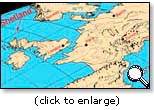
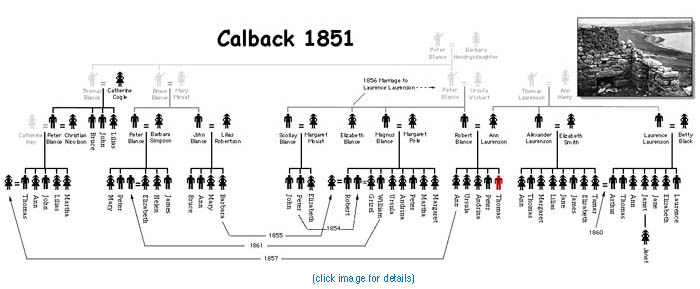
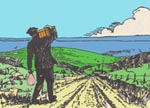
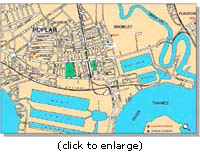
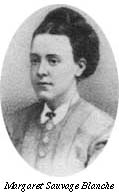 Tom and Margaret set up house on the west side of Poplar just north of East
India Dock Road in a small two-room appartmen
Tom and Margaret set up house on the west side of Poplar just north of East
India Dock Road in a small two-room appartmen